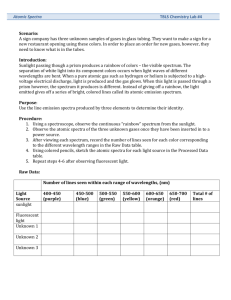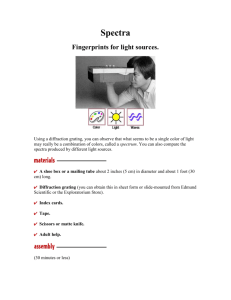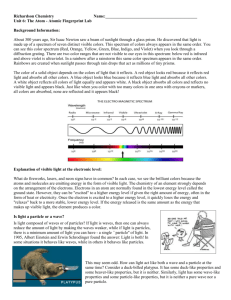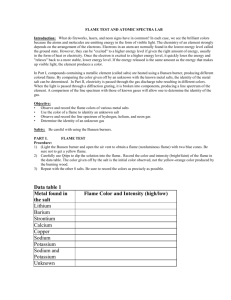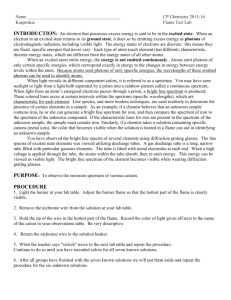41G Astronomy - Spectra Lab
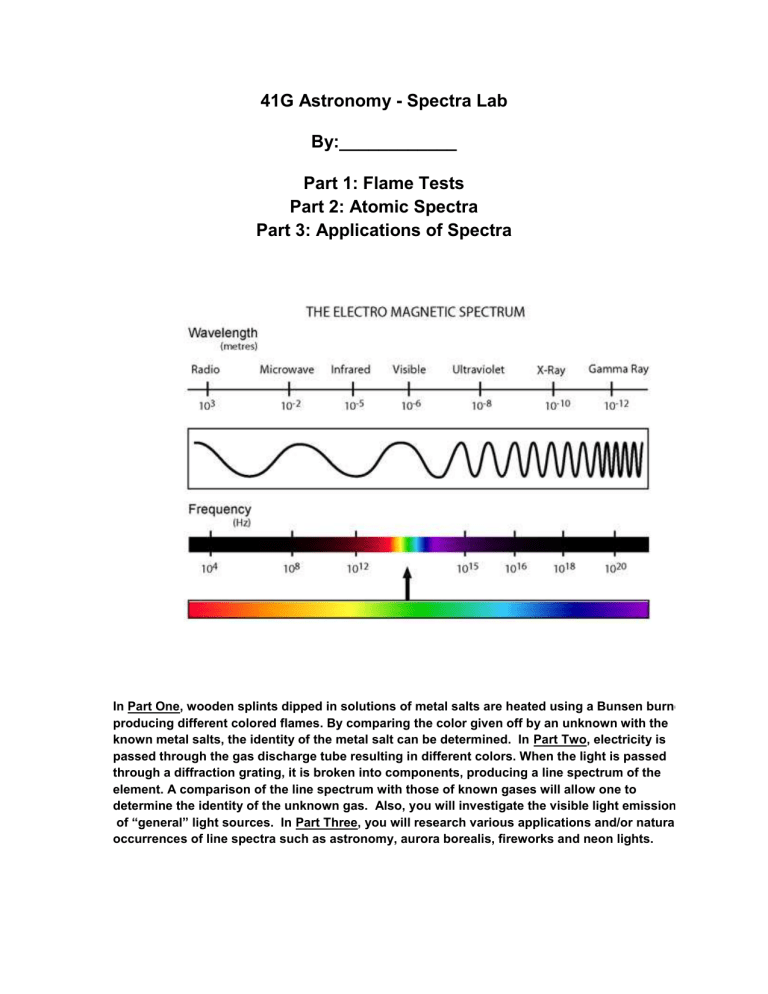
41G Astronomy - Spectra Lab
By:____________
Part 1: Flame Tests
Part 2: Atomic Spectra
Part 3: Applications of Spectra
In Part One, wooden splints dipped in solutions of metal salts are heated using a Bunsen burner, producing different colored flames. By comparing the color given off by an unknown with the known metal salts, the identity of the metal salt can be determined. In Part Two, electricity is passed through the gas discharge tube resulting in different colors. When the light is passed through a diffraction grating, it is broken into components, producing a line spectrum of the element. A comparison of the line spectrum with those of known gases will allow one to determine the identity of the unknown gas. Also, you will investigate the visible light emissions of “general” light sources. In Part Three, you will research various applications and/or natural occurrences of line spectra such as astronomy, aurora borealis, fireworks and neon lights.
Part One: Flame Tests
When solutions of metals are heated in a Bunsen burner flame, they give off characteristic colours.
For example, sodium makes the flame turn bright yellow – this is the same yellow colour made by sodium street lamps and many fireworks.
Materials:
● Bunsen burner
● Wooden splints (7 per group)
● Solutions (1.0 mol/L) of the following metal salts:
○ lithium chloride
○ strontium chloride
○ calcium chloride
○ copper(II)chloride
○ sodium chloride
○ potassium chloride
○ sodium chloride/potassium chloride mixture
● cobalt blue glass
Procedure:
1.
Obtain a cobalt blue glass and 7 wooden splints that have been soaking in the metal salt
solutions (Why is soaking the splints important?). Be sure to label each wooden splint with the
names of the salts so they are not mixed up.
2.
Light the Bunsen burner and open the air vent to obtain a non-luminous flame with two blue
cones. Be sure to avoid a yellow flame. (Why?)
3.
Carefully place the end of the wooden splint that was soaked in the metal salt solution at the top of the inner blue cone. Record the color and intensity (bright/faint) of the flame in the data table.
The color given off by the salt is the initial color observed, not the yellow-orange color produced by the burning wood. (To avoid burning the wood, wave the splint through the flame rather than
holding it right in the flame).
4.
Repeat with the other 6 salts. Be sure to record the colors as precisely as possible.
5.
For the sodium potassium mixture, observe the colors as before and then again by looking
through the cobalt glass. The cobalt glass cuts out any yellow-orange color.
6.
If more observations are needed, dip the clean end of the wooden splint in the solutions for a few minutes and repeat. Otherwise, discard the wooden splints at the end of the experiment.
Observation Data Table:
Make a prediction what color you think the flame is going to be BEFORE you begin!
Metal found in the salt
Flame Color and Intensity
Prediction (Hypothesis)
Actual Color
(confirmed)
Lithium
Strontium
Calcium
Copper
Sodium
Potassium
Sodium and Potassium
Without cobalt blue glass:
With cobalt blue glass:
Analysis:
The electromagnetic spectrum is shown at the beginning of this document.
Recall that energy is proportional to frequency, while frequency is inversely proportional to wavelength. Use this information to answer questions 1-4 below.
1.
List the colors observed in this lab from the highest energy to the lowest energy.
2.
List the colors observed in this lab from the highest frequency to the lowest frequency.
3.
List the colors observed in this lab from the shortest wavelength to the longest wavelength.
4.
What is the relationship between energy, frequency, and wavelength?
5.
Why do different chemicals emit different colors of light?
Part Two: Atomic Spectra
During this experiment you will make use of a device known as a diffraction grating spectrometer. A diffraction grating splits a single beam of light into the many colors which it contains. The colors should be ordered like a rainbow, from blue on one side to red on the other. The brightness of the image in each color shows you how much light the object is emitting of that color.
We will be using these diffraction gratings to look at "spectral tubes". These are tubes which contain gases composed of different elements. By plugging these tubes into the wall, we can send electricity through them, which adds energy to the gas. This causes the atoms to become "excited", which is how we describe atoms whose electrons have been raised into high energy levels. After a short amount of time the electrons drop back into lower energy states, releasing a photon to carry off the extra energy.
Depending on the number of transitions in each atom and the energy levels in it, photons of different wavelengths and thus different colors are released from each gas.
Each element has its own unique line spectrum and is thus referred to as the “fingerprint” for a particular element. The spectra for each element are unique because each element contains differing numbers of electrons and thus different energy levels.
Think about the following questions as you look at the spectral lines corresponding to each gas:
●
Are the lines closely packed, or spread out over many different colors?
●
Are there many lines you can see, or only a few?
●
How do the colors of the lines from each tube relate to the color you see from each tube when you don't look through the gratings?
You will also be observing other light sources to see how their spectra compare to that of the gas tubes.
Materials:
● gas discharge tube
● gas filled tubes (hydrogen, helium, neon, argon, mercury, and an unknown)
● spectroscope/diffraction grating tube (or glasses)
● incandescent light (40W light bulb)
● fluorescent light
● bug light
Procedure:
1. Go to one of the lab stations where a hydrogen gas discharge tube is set up.
2. Turn on the electricity (for no more than 30 seconds) and observe the color given off by the gas. Record your observations in the data table below. If more time for observation is needed, turn off the tube for ~15 seconds and then turn on for another 30 seconds. Do not leave the tube continuously turned on; otherwise, it will burn out the tube.
3. Hold the spectrometer so the diffraction slit is towards the light source and the diffraction grating
(window) is towards you. (See diagram below).
4. Look through the diffraction grating and observe and record the colored lines (spectrum) produced by oxygen gas. Record only one set of colors.
Complete the observation data table
1 and then draw the color lines in the spectrum boxes that follow.Repeat this step with Argon, Nitrogen, Neon and Mercury.
6. Investigate a series of general light sources such as indirect sunlight
(Never look directly at the sun!) , shade, fluorescent lights, a light bulb, etc. and record what is observed in observation data table 2 and draw the color lines in the spectrum boxes that follow.
Observation Data Table 1 (Line spectra of elements):
Color of the Discharge
Tube
Number of different colored lines in the spectrum
Oxygen
Argon
Nitrogen
Neon
Mercury
Draw a detailed view of the spectra (including approximate wavelengths) observed below:
Observation Data Table 2 - Spectra of other Light Sources:
Color of the discharge tube Line or continuous Spectra
(or both)?
40W incandescent light bulb
Indirect Sunlight
Partial Shade
Fluorescent Light
Bug Light
Create a drawing of the spectral lines that you observe below.
Analysis:
1. What is the difference between a line spectrum and a continuous spectrum? Provide an example of each.
2. Which light source produced both a continuous and a line spectrum?
3. Which element produced the largest number of lines? Which element produced the smallest number of lines? Explain why elements produce different numbers of spectral lines.
4. Do you notice a similarity in the line spectrum of Mercury and the spectrum observed with the fluorescent bulb? Explain why this might be.
5. Each element has its own unique line emission spectrum, just like fingerprints. Explain how this technique can be used to determine the elemental composition of stars.
Part Three: Applications of Line Spectra
Research the various applications and/or natural occurrences of line spectra. Choose one of astronomy, aurora borealis (Northern lights), fireworks, lasers, street lamps and neon lights. Include your understanding of the internal structure of atoms and the relationship between electrons and light.
Research Focus:
○
What is the topic you are exploring?
○
Fully describe the topic. Explain their occurrence/how they work. Relate your topic to the electromagnetic spectrum. Include your understanding of the internal structure of atoms and the relationship between electrons and light.



